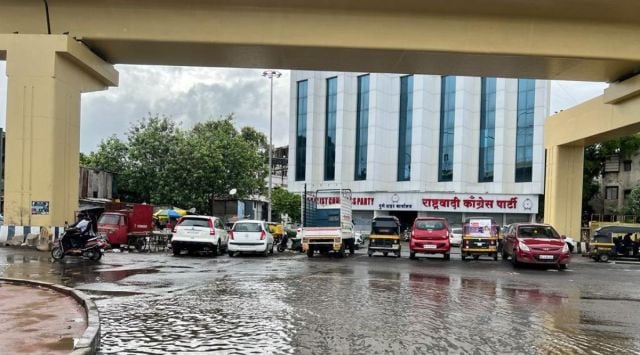Click here to join Express Pune WhatsApp channel and get a curated list of our stories
Monitoring teams, phone groups: Pune traffic police gets ready to face monsoon logjam
During the monsoon of 2022, several key roads in the city witnessed massive traffic jams, especially on days that witnessed heavy rains, and during peak hours.
 Waterlogging next to Dengle bridge near PMC headquarters on Wednesday. (Express photo by Arul Horizon)
Waterlogging next to Dengle bridge near PMC headquarters on Wednesday. (Express photo by Arul Horizon) With the monsoon setting in, Pune city’s Traffic Control Branch officials are ready with a multi-agency plan of action and a set of Standard Operating Procedures in their bid to avert massive jams witnessed last time – and deal with various eventualities, including flooding.
During the monsoon of 2022, several key roads in the city witnessed massive traffic jams, especially on days that witnessed heavy rains, and during peak hours. These jams were mainly attributed to waterlogging, various ongoing public work projects, including Pune Metro, issues with sewage and water drainage systems systems, malfunctioning of traffic signals and encroachments, in addition to increased number of four wheelers on the roads due to rains.
On May 31, Pune Police Commissioner Retesh Kumaarr and Municipal Commissioner Vikram Kumar co-chaired a meeting at Pune Police commissionerate which was attended by officials from several stakeholder agencies, including Pune Municipal Corporation (PMC), Pune Metro, Pune Metropolitan Regional Development Authority (PMRDA), Pune Cantonment Board, Pune Mahanagar Parivahan Mahamandal Ltd (PMPML), Smart City Project and the Public Works Department.
Deputy Commissioner of Police (Traffic) Vijaykumar Magar said, “Following the multi-agency review of infrastructure and services, all stakeholder agencies have been directed to set up monitoring teams at their respective offices for quick and efficient response to situations arising during the monsoon season and all these teams have been linked to each other. For coordination, phone messenger groups have been formed which will comprise of all officials from these agencies. We have identified as many as 114 points across 27 traffic divisions, where possible waterlogging during heavy rains can lead to traffic jams and have communicated this list to the PMC and other concerned bodies. The in-charge inspectors from each of the traffic divisions have held coordination meetings in their jurisdiction to take point by point review of spots that may witness traffic issues during rains.”
DCP Magar said, “We have also prepared a set SOPs for each of the possible scenarios including flooding, waterlogging, tree collapse, power failures, etc. Each of the SOPs include steps to be taken by individual agencies and how the traffic control branch will coordinate with them.”
Police Inspector (Traffic Planning) Arjun Botre said, “Several preemptive measures have been taken by the in-charge inspector of the individual traffic divisions. For example, if there were any tree branches that were at risk of falling, we have requested that they be cut in advance. If there were potholes or flaws in road structures that needed correction, then the respective civic body officials have been alerted. During such situations of heavy traffic during rains, the majority of the strength of the traffic control branch will be on the roads to resolve the situation.”
Click here to join Express Pune WhatsApp channel and get a curated list of our stories







